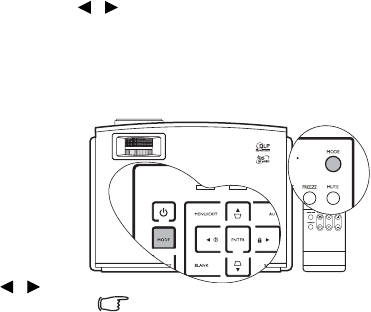
30
Operation
Optimizing the image
Using Wall Color
In the situation where you are projecting onto a colored surface such as a painted wall which may not be white,
the Wall Color feature can help correct the projected picture’s color to prevent possible color difference between
the source and projected pictures.
To use this function, go to the DISPLAY > Wall Color menu and press / to select a color which is the closest
to the color of the projection surface. There are several precalibrated colors to choose from: Light Yellow, Pink,
Light Green, Blue, and Blackboard
Selecting a picture mode
The projector is preset with several predefined picture modes so that
you can choose one to suit your operating environment and input
signal picture type.
To select a operation mode that suits your need, perform one of the
following steps.
•Press MODE on the projector or remote control repeatedly until
your desired mode is selected.
•Go to the PICTURE > Picture Mode menu and press / to
select a desired mode.
The picture modes available for different types of signals are listed
below.
PC input signals: D-Sub/Comp. (analog RGB), and DVI-D (DVI-D)
1. Dynamic mode (Default): Maximizes the brightness of the projected image. This mode is suitable for
environments where extra-high brightness is required, such as using the projector in well lit rooms.
2. Presentation mode: Is designed for presentations. The brightness is emphasized in this mode to match PC
and notebook coloring.
3. sRGB mode: Maximizes the purity of RGB colors to provide true-to-life images regardless of brightness
setting. It is most suitable for viewing photos taken with an sRGB compatible and properly calibrated
camera, and for viewing PC graphic and drawing applications such as AutoCAD.
4. Cinema mode: Is appropriate for playing colorful movies, video clips from digital cameras or DVs through
the PC input for best viewing in a blackened (little light) environment.
5. User 1/User 2 mode: Recalls the settings customized based on the current available picture modes. See
"Setting the User 1/User 2 mode" on page 31 for details.
Video input signals: Component (YPbPr), S-Video, Video, D-Sub/Comp. (YPbPr), DVI-D (HDCP/
HDMI)
1. Dynamic mode: Is suitable for playing gamebox-based video games in a normal living room lighting level
environment.
2. Standard mode (Default): Is appropriate for viewing colorful movies, video clips from digital cameras or
DVs.
3. Cinema mode: Is suitable for enjoying dark movies or DVD movies best viewed in a blackened (little light)
home cinema or lounge room environment.
4. User 1/User 2 mode: Recalls the settings customized based on the current available picture modes. See
"Setting the User 1/User 2 mode" on page 31 for details. The User 1 and User 2 modes here are different
from the User 1 and User 2 modes defined under the D-Sub/Comp. (analog RGB)/DVI-D (DVI-D) signal
input.
A slight variation in the picture
brightness and colors may be
observed during the very short
time of switching picture
modes.


















